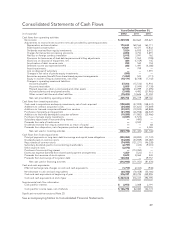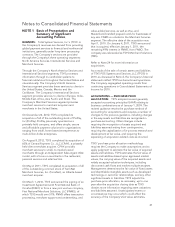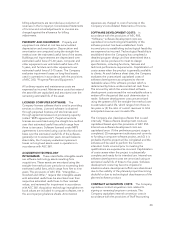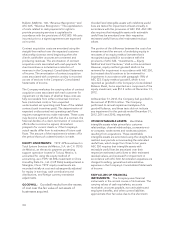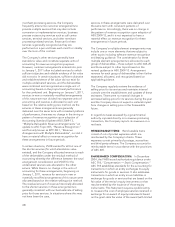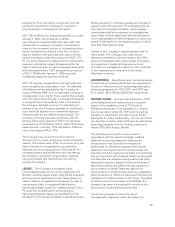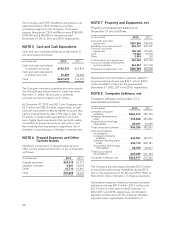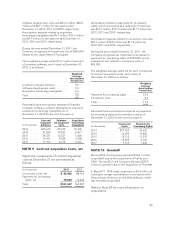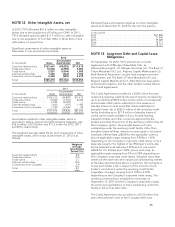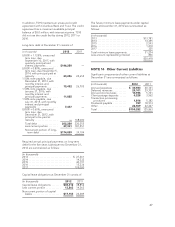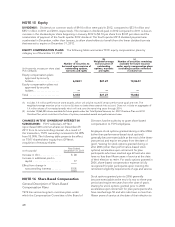NetSpend 2012 Annual Report Download - page 41
Download and view the complete annual report
Please find page 41 of the 2012 NetSpend annual report below. You can navigate through the pages in the report by either clicking on the pages listed below, or by using the keyword search tool below to find specific information within the annual report.merchant processing services, the Company
frequently enters into customer arrangements to
provide multiple services that may also include
conversion or implementation services, business
process outsourcing services such as call center
services, terminal services, and other merchant
processing-related services. Revenue for these
services is generally recognized as they are
performed on a per unit basis each month or ratably
over the term of the contract.
The Company’s other services generally have
standalone value and constitute separate units of
accounting for revenue recognition purposes.
However, customer arrangements entered into prior
to January 1, 2011 often included services for which
sufficient objective and reliable evidence of fair value
did not exist. In certain situations, sufficient objective
and reliable evidence of fair value did not exist for
multiple undelivered services, and the deliverables
were combined and recognized as a single unit of
accounting based on the proportional performance
for the combined unit. Beginning on January 1, 2011,
services in new or materially modified arrangements
of this nature are now divided into separate units of
accounting and revenue is allocated to each unit
based on the relative selling price method. As the
services in these arrangements are generally
delivered over the same term with consistent patterns
of performance, there was no change in the timing or
pattern of revenue recognition upon adoption of
Accounting Standard Update (ASU) 2009-13,
“Multiple-Deliverable Revenue Arrangements,” an
update to ASC Topic 605, “Revenue Recognition,”
and formerly known as EITF 08-1, “Revenue
Arrangements with Multiple Deliverables”, nor did it
have a material effect on revenue recognition for
these arrangements in future periods.
In certain situations, VSOE existed for all but one of
the shorter services (for which standalone value
existed), and the Company allocated revenue to each
of the deliverables under the residual method of
accounting whereby the difference between the total
arrangement consideration and VSOE for the
undelivered services was allocated to the other
service. While there is no change in the units of
accounting for these arrangements, beginning on
January 1, 2011, revenue for services in new or
materially modified arrangements of this nature were
allocated based on the relative selling price method.
The residual amount of revenue historically allocated
to the shorter services in these arrangements is
generally consistent with our best estimate of selling
price for those services. In situations where this may
not have been the case,
services in these arrangements were delivered over
the same term with consistent patterns of
performance. Accordingly, there was no change in
the pattern of revenue recognition upon adoption of
ASU 2009-13, and it is not expected to have a
material effect on revenue recognition for these
arrangements in future periods.
The Company’s multiple element arrangements may
include one or more elements that are subject to
other topics including software revenue recognition
and leasing guidance. The consideration for these
multiple element arrangements is allocated to each
group of deliverables – those subject to ASC 605-25
and those subject to other topics based on the
revised guidance in ASU 2009-13. Arrangement
revenue for each group of deliverables is then further
separated, allocated, and recognized based on
applicable guidance.
The Company regularly reviews the evidence of
selling price for its services and maintains internal
controls over the establishment and updates of these
estimates. There were no material changes in
estimated selling price for its services during the year
and the Company does not expect a material impact
from changes in selling price in the foreseeable
future.
In regards to taxes assessed by a governmental
authority imposed directly on a revenue producing
transaction, the Company reports its revenues on a
net basis.
REIMBURSABLE ITEMS: Reimbursable items
consist of out-of-pocket expenses which are
reimbursed by the Company’s clients. These
expenses consist primarily of postage, access fees
and third party software. The Company accounts for
reimbursable items in accordance with the provisions
of ASC 605.
SHARE-BASED COMPENSATION: In December
2004, the FASB issued authoritative guidance under
ASC 718, “Compensation — Stock Compensation.”
ASC 718 establishes standards for the accounting for
transactions in which an entity exchanges its equity
instruments for goods or services. It also addresses
transactions in which an entity incurs liabilities in
exchange for goods or services that are based on the
fair value of the entity’s equity instruments or that
may be settled by the issuance of those equity
instruments. This Statement requires a public entity
to measure the cost of employee services received in
exchange for an award of equity instruments based
on the grant-date fair value of the award (with limited
38



